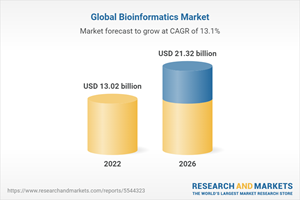World Bioinformatics Market Report 2022, Featuring Profiles of Agilent Technologies, Illumina, QIAGEN, Celera, Tripos and Perkinelmer

Global Bioinformatics Market

Dublin, April 19, 2022 (GLOBE NEWSWIRE) -- The "Bioinformatics Global Market Report 2022, By Products and Services, By Application, By End Users" report has been added to ResearchAndMarkets.com's offering.
The global bioinformatics market is expected to grow from $11.55 billion in 2021 to $13.02 billion in 2022 at a compound annual growth rate (CAGR) of 12.7%.The market is expected to reach $21.32 billion in 2026 at a CAGR of 13.1%.
Increasing demand for protein sequencing is driving growth in the bioinformatics market. Protein sequencing refers to the process of determining the sequence of amino acids in all or part of the proteins present in DNA, based on which specific functions, activities, origin or localization of the protein is determined. Protein sequencing helps analysts to understand the distribution of amino acids along the sequences and the structure of proteins. With bioinformatics methods and databases, capacity, structure and developmental history of proteins can be effectively identified. The demand for protein sequencing is expected to grow on account of factors such as advancements in clinical mass spectrometry and analytical techniques, and significant adoption of target-based drug development by pharmaceutical and biotechnology companies. For instance, in 2021, the total number of protein sequences in UniProtKB, which is a freely accessible database of protein sequence and functional information, increased to approximately 190 million.
Lack of interoperability among various available data formats is acting as a restraint on the bioinformatics market. Various data formats come with differences in structures of data. There are numerous protein databases available through various resources, and each database chooses to represent proteins in a different format. Also, different data models such as object data model or relational data model are used while collecting data. Therefore, the problem of interoperability arises when a researcher tries to integrate the results of unique databases present in different data formats. Various data formats available for bioinformatics include Compressed Row Storage (CRS), Sparse Vector, Avro, Parquet and ORC (Optimized Row Compressed).
Companies in the bioinformatics market are increasingly investing in the research and development of nanopore sequncing technology. Nanopore sequencing is a single molecule DNA sequencing technology which eliminates the need for Polymerase Chain Reaction or chemical labelling of the sample. This technology passes ionic current through nanopores (a pore of nanometer size) and when the biological molecules pass through the nanopores or near to it then this technology measures the changes in current which can be used to identify the molecule. Nanopore sequencing technology offers high throughput, low cost, longer reads (Sequence of a section of a unique fragment) to the analyst and helps in the collection of data which is an essential part of bioinformatics. For instance, in 2020, Oxford Nanopore Technologies raised $109.5 million to support the ramp of commercial and manufacturing operations and to further develop its nanopore technology.
The bioinformatics market is governed by various regulatory bodies for quality and compliance of bioinformatics platforms. For instance, in India, the Biotechnology Industry Research Assistance Council (BIRAC), set up by Department of Biotechnology (DBT), Government of India, regulates the bioinformatics market. BIRAC introduces Technology Readiness Levels (TRLs) as a measure of estimating the maturity of technology while in the evaluation phases until these technologies are complete to be offered commercially. The TRL scale provides 9 technology readiness levels with TRL1 being the stage when the technology is ideated, and TRL9 being the stage when the technology is ready for commercial use. The manufacturers have to get past TRL9 to have their product available commercially and ready to be marketed. These TRL's consist of various levels of compliance and processes that the manufacturers must adhere to. The bioinformatics platform is evaluated for quality, feasibility, data privacy and protection as per international standards.
The report focuses on the bioinformatics market which is experiencing strong growth.
Report Scope
Markets Covered:
By Products and Services: Knowledge Management Tools; Data Analysis Platforms; Services
By Application: Metabolomics; Molecular Phylogenetics; Transcriptomics; Proteomics; Chemoinformatics; Genomics; Others
By End Users: Pharmaceutics; Animal Study; Agriculture; Forensic Science; Other End Users
Countries: Australia; Brazil; China; France; Germany; India; Indonesia; Japan; Russia; South Korea; UK; USA
Regions: Asia-Pacific; Western Europe; Eastern Europe; North America; South America; Middle East; Africa
Time Series: Five years historic and ten years forecast.
Data Segmentations: country and regional historic and forecast data, market share of competitors, market segments.
Companies Mentioned
Agilent Technologies
Illumina
QIAGEN
Affymetrix
Thermo Fisher Scientific
BGI
Dassault Systems
Eurofins scientific
Bruker Daltonics
Biomax Informatix
DNASTAR
Partek
Geneva Bioinformatics
Perkinelmer Inc.
Accelrys
SA Nonlinear Dynamics
Quest Diagnostics
Sophia Genetics
Waters Corporation
Permin Elmer Inc.
Applied Biologicals Materials
Life Technologies
PerkinElmer
Waters Corporation
Sophia Genetics
Celera
Tripos
LP
Helicos Biosciences Incorporation
IBM Life Sciences
For more information about this report visit https://www.researchandmarkets.com/r/z43pze
About ResearchAndMarkets.com
ResearchAndMarkets.com is the world's leading source for international market research reports and market data. We provide you with the latest data on international and regional markets, key industries, the top companies, new products and the latest trends.
Attachment
CONTACT: CONTACT: ResearchAndMarkets.com Laura Wood, Senior Press Manager press@researchandmarkets.com For E.S.T Office Hours Call 1-917-300-0470 For U.S./CAN Toll Free Call 1-800-526-8630 For GMT Office Hours Call +353-1-416-8900


 Yahoo Finance
Yahoo Finance 
